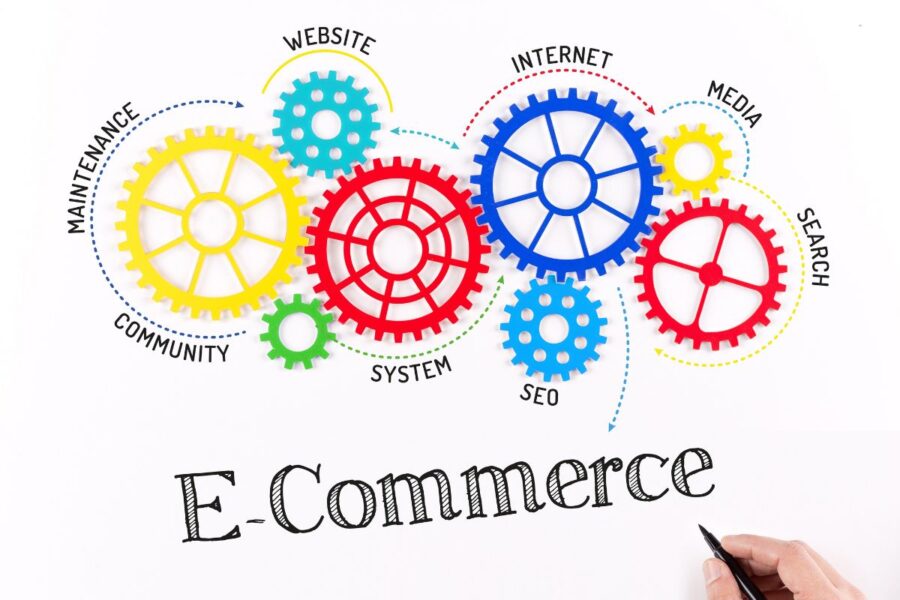E-commerce has revolutionized the way businesses operate, offering the flexibility to manage and grow an online store from virtually anywhere in the world. For travel enthusiasts, this means the opportunity to combine a passion for exploration with running a successful e-commerce business.
This comprehensive blog post will touch into the key aspects of ecommerce brands i-commerce management, providing insights into effective ecommerce management strategies, tools, and best practices to ensure your online store thrives, no matter where your travels take you.
Understanding E-commerce Management
E-commerce management involves overseeing all aspects of an ecommerce manager, online store or ecommerce manager’s operations, from inventory management to customer service. It’s about ensuring that every component of the e-commerce business works seamlessly together to drive sales and enhance customer satisfaction.
Key Components of E-commerce Management
Effective e-commerce management consists of several critical components that ensure the smooth operation of commerce sales in an online store:
- Inventory Management: Keeping track of stock levels to meet customer demand without overstocking or understocking.
- Order Management: Handling the process from order placement to delivery, ensuring timely and accurate fulfillment.
- Customer Relationship Management: Building and maintaining relationships with customers to drive repeat business and loyalty.
- Website Performance: Ensuring the e-commerce website runs smoothly, with fast loading times and a user-friendly interface.
- Marketing and Sales: Implementing strategies to attract and convert customers, including search engine optimization (SEO) and digital marketing techniques.
Effective E-commerce Management Strategies
Inventory Management
Effective inventory management is crucial for preventing lost sales and maintaining customer satisfaction. Here are some strategies to manage inventory efficiently:
- Use Inventory Management Systems: Implement systems that automate inventory tracking, update stock levels in real-time, and generate alerts for low stock.
- Track Inventory Accurately: Regularly audit inventory to ensure that physical stock matches system records.
- Forecast Demand: Analyze customer data and market trends to predict future demand and adjust inventory levels accordingly.
Customer Satisfaction and Engagement
Customer satisfaction is a key driver of repeat business and customer loyalty. To improve customer satisfaction, consider the following:
- Provide Excellent Customer Service: Respond promptly to customer inquiries and resolve issues efficiently.
- Engage Customers: Use personalized communication and offers to engage customers and make them feel valued.
- Gather and Utilize Customer Data: Collect data on customer preferences and behavior to tailor your offerings and improve the customer journey.
Pricing Strategies
Developing effective marketing team pricing strategies is essential for staying competitive and maximizing profits:
- Competitive Pricing: Monitor competitor prices and adjust your pricing to remain competitive.
- Dynamic Pricing: Use dynamic pricing strategies to adjust prices based on demand, seasonality, and other factors.
- Value-Based Pricing: Price products based on the perceived value to the customer rather than just the cost.
Website Performance and Optimization
A well-performing website is crucial for providing a seamless, full online shopping and cart experience:
- Optimize Loading Times: Ensure your website loads quickly by optimizing images, using caching, and minimizing code.
- Enhance User Experience: Design a user-friendly interface with easy navigation, clear product descriptions, and a simple checkout process.
- Implement SEO: Use search engine optimization techniques to improve your website’s visibility on search engines and attract more organic traffic.
Utilizing E-commerce Management Tools
To streamline e-commerce operations e commerce and online businesses everywhere, leveraging the right tools is essential:
- E-commerce Platforms: Use robust platforms like Shopify, WooCommerce, or Magento to manage your online store.
- Inventory Management Tools: Tools like TradeGecko or Zoho Inventory can help automate and optimize inventory processes.
- Customer Relationship Management (CRM) Systems: CRMs like Salesforce or HubSpot help manage customer interactions and data.
- Analytics Tools: Google Analytics provides valuable insights into website performance and customer behavior.
Case Study: Running an Online Store While Traveling
Imagine managing a thriving e-commerce business while exploring new destinations. Here’s a hypothetical case study of how a travel enthusiast successfully balances both:
The Setup
Alex, an avid traveler, runs an online store selling eco-friendly travel gear. By leveraging e-commerce management solutions, Alex can his his ecommerce store website, manage inventory, fulfill orders, and engage with customers from anywhere in the world.
Inventory Management
Alex uses an inventory management system that tracks stock levels in real-time and integrates with the inventory control the online store. This system sends automated alerts for low stock and generates purchase orders for suppliers, ensuring that popular items are always available.
Customer Engagement
To maintain customer satisfaction, Alex uses a CRM to personalize communication and offer targeted promotions based on customer data. Regular email newsletters keep customers informed about new products and special offers.
Website Optimization
Alex ensures the online store is optimized for mobile users, with fast loading times and an intuitive interface. SEO strategies help drive organic traffic, while social media marketing campaigns attract new customers.
The Result
By leveraging effective e-commerce management strategies and tools, Alex can focus on traveling and exploring new destinations while maintaining a successful online business. The flexibility and scalability of e-commerce allow Alex to manage operations seamlessly, no matter where the journey leads.
Advanced E-commerce Management Strategies for Travelers
As a travel enthusiast running an e-commerce business, it’s crucial to leverage advanced strategies from ecommerce managers to ensure operational efficiency and business growth while exploring new destinations. This section will delve deeper into sophisticated ecommerce management solutions and-commerce management techniques that can help you optimize your online store, enhance customer satisfaction, and increase sales.
Leveraging Data-Driven Decisions
Data is the backbone of effective, ecommerce platform, platforms and-commerce management. By analyzing customer data and market trends, you can make informed decisions that drive your business forward.
Utilizing Customer Data
- Customer Preferences: Track and analyze customer preferences to tailor your product offerings. Use customer relationship management (CRM) systems to collect and manage customer data.
- Purchase Behavior: Understand the purchasing patterns of your customers. Identify peak shopping times, preferred payment methods, and popular products to optimize your marketing efforts.
- Customer Feedback: Regularly gather and analyze customer feedback to improve your products and services. Implement changes based on feedback to enhance customer satisfaction.
Using Analytics Tools
- Google Analytics: Monitor website performance, track user behavior, and measure the effectiveness of marketing campaigns.
- E-commerce Platforms: Use built-in analytics tools on platforms like Shopify or WooCommerce to gain insights into sales performance, customer demographics, and traffic sources.
- Heatmaps: Tools like Hotjar can help you understand how visitors interact with your website, allowing you to optimize the user experience.
Enhancing Customer Engagement and Loyalty
Building strong relationships with your most loyal customers is essential for further customer acquisition, driving repeat business and fostering loyalty.
Customer Engagement Strategies
- Personalized Marketing: Use customer data to create personalized marketing campaigns. Tailor emails, product recommendations, and promotions to individual customer preferences.
- Loyalty Programs: Implement loyalty programs to reward repeat customers. Offer points for purchases, exclusive discounts, and early access to new products.
- Social Media Interaction: Engage with your customers on social media platforms. Respond to comments, share user-generated content, and run interactive campaigns to build a community around your brand.
Improving Customer Retention
- Excellent Customer Service: Provide timely and helpful customer support. Use chatbots and helpdesk software to manage inquiries efficiently.
- Customer Retention Strategies: Implement strategies such as follow-up emails, satisfaction surveys, and special offers for existing customers to encourage repeat purchases.
- Addressing Customer Complaints: Promptly address and resolve customer complaints. Show empathy and take corrective actions to maintain trust and satisfaction.
Optimizing Supply Chain and Order Management
Efficient supply chain and order management are critical for meeting customer expectations and minimizing operational costs.
Inventory Management Best Practices
- Automated Systems: Use inventory management systems to automate stock tracking and reordering processes. Tools like TradeGecko or Zoho Inventory can streamline inventory management.
- Real-Time Tracking: Implement real-time inventory tracking to prevent stockouts and overstocking. Keep accurate records of stock levels across all sales channels.
- Supplier Relationships: Maintain strong relationships with suppliers to ensure timely deliveries and negotiate better terms.
Streamlining Order Fulfillment
- Order Management Software: Use order management software to automate order processing, from receiving orders to shipping. Tools like ShipStation or Orderhive can help manage order fulfillment efficiently.
- Shipping Optimization: Optimize shipping processes to reduce costs and improve delivery times. Offer multiple shipping options and use reliable carriers to ensure timely deliveries.
- Returns Management: Implement a clear and customer-friendly returns policy. Use returns management software to handle returns efficiently and maintain customer satisfaction.
Implementing Effective Marketing Campaigns
Marketing is a crucial component of an effective ecommerce management strategy in-commerce management, driving traffic and sales to your online and physical retail store.
Digital Marketing Techniques
- Search Engine Optimization (SEO): Optimize your website for search engines to improve visibility and attract organic traffic. Focus on keyword research, on-page SEO, and link building.
- Email Marketing: Use email marketing to nurture leads and engage with existing customers. Send personalized emails, product recommendations, and promotional offers.
- Social Media Marketing: Leverage social media platforms to promote your products and engage with your audience. Use paid ads, influencer collaborations, and content marketing to reach a broader audience.
Running Marketing Campaigns
- Seasonal Campaigns: Plan and execute marketing campaigns around seasonal events and holidays. Offer special discounts and promotions to attract customers.
- Product Launches: Create buzz around new product launches with teaser campaigns, pre-orders, and exclusive offers.
- Content Marketing: Develop high-quality content that provides value to your audience. Use blogs, videos, and infographics to educate and engage your customers.
Ensuring Secure Payment Processing
Secure payment processing is vital for protecting customer information and building trust.
Secure Payment Gateways
- Payment Gateways: Use reputable payment gateways like PayPal, Stripe, or Square to process transactions securely.
- SSL Certificates: Ensure your website has an SSL certificate to encrypt personal and financial information during transactions.
- Fraud Prevention: Implement fraud prevention measures such as address verification, CVV checks, and multi-factor authentication to protect against fraudulent transactions.
Continuous Improvement Through Market Research
Staying ahead of the competition requires continuous improvement and adaptation to market trends.
Conducting Market Research
- Competitive Analysis: Regularly analyze competitors to identify their strengths and weaknesses. Use this information to refine your strategies and differentiate your offerings.
- Customer Surveys: Conduct surveys to gather insights into customer needs, preferences, and satisfaction levels. Use the feedback to improve products and services.
- Trend Analysis: Monitor industry trends and emerging technologies to stay updated and innovate your business practices.
Adapting E-commerce Management for Travel Enthusiasts
For travel enthusiasts, managing an e-commerce business while on the go presents unique challenges and opportunities. By leveraging mobile-friendly tools, adopting flexible working practices, and staying connected with your team, you can effectively run your online store from anywhere in the world. This section will provide practical tips and strategies for adapting e-commerce management to fit a travel-centric lifestyle.
Mobile-Friendly E-commerce Management Tools
Using mobile-friendly tools allows you to manage your e-commerce business efficiently while traveling. Here are some essential tools:
Inventory Management Apps
- TradeGecko Mobile: Manage inventory, track orders, and access customer information from your mobile device.
- Zoho Inventory: Offers mobile access to inventory management features, making it easy to track stock levels and manage orders on the go.
Customer Relationship Management (CRM) Apps
- Salesforce Mobile: Access customer data, manage leads, and track sales performance from your smartphone.
- HubSpot CRM Mobile: Manage customer interactions, view contact information, and track deals from a mobile-friendly interface.
Project Management and Collaboration Tools
- Trello: Use Trello’s mobile app to organize tasks, collaborate with your team, and keep track of project progress.
- Asana: Manage tasks, set deadlines, and communicate with your team using Asana’s mobile app.
Flexible Working Practices
Adopting flexible working practices can help you balance travel and your own ecommerce management and businesses i-commerce management effectively.
Time Management
- Set Priorities: Focus on high-priority tasks that have the most significant impact on your business. Use tools like Eisenhower Matrix to prioritize your tasks.
- Create a Routine: Establish a daily routine that includes dedicated time for managing your e-commerce business. This helps maintain consistency and productivity.
Remote Team Collaboration
- Regular Check-Ins: Schedule regular check-ins with your team to discuss progress, address challenges, and plan future tasks.
- Clear Communication: Use clear and concise communication to ensure everyone is on the same page. Tools like Slack and Microsoft Teams facilitate real-time communication and collaboration.
Conclusion
Managing an e-commerce business while traveling is entirely feasible with the right tools, strategies, and practices. By leveraging mobile-friendly apps, adopting flexible working practices, staying connected, and automating tasks, you can successfully run your online store from anywhere in the world. As you explore new destinations, these insights will help you maintain and grow your e-commerce business, ensuring continued success and satisfaction with target customers.
FAQs
What is e-commerce management?
E-commerce management involves overseeing all aspects of an online store’s operations, from inventory management to customer service, ensuring the smooth running and profitability of the business.
What is the role of an e-commerce manager?
An e-commerce manager is responsible for managing an online store, including tasks such as inventory management, order fulfillment, customer service, website optimization, and marketing strategies to drive sales and customer satisfaction for online retailers and stores.
What is e-commerce operations management?
E-commerce operations or ecommerce management refers to the processes and activities involved in running an ecommerce site or online store, including inventory management, order processing, customer service, and maintaining website performance.
Who manages e-commerce in a business?
E-commerce in a business is typically managed by an e-commerce manager or a team of professionals responsible for various aspects of the online sales or selling online or store, such as marketing, inventory management, customer service, and website maintenance.












